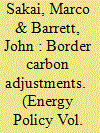| Srl | Item |
| 1 |
ID:
150462


|
|
|
|
|
| Summary/Abstract |
Approximately one fourth of global emissions are embodied in international trade and a significant portion flows from non-carbon-priced to carbon-priced economies. Border carbon adjustments (BCAs) figure prominently as instruments to address concerns arising from unilateral climate policy. Estimating the volume of emissions that could be potentially taxed under a BCA scheme has received little attention until now. This paper examines how a number of issues involved in the implementation of BCAs can affect their ability to cover emissions embodied in trade and thus address carbon leakage. These issues range from ensuring compliance with trade provisions and assumptions on the carbon intensity of imports, to determining which countries are included and whether intermediate and final demand are considered. Here we show that the volume of CO2 captured by a scheme that involved all Annex B countries could be significantly reduced due to these issues, particularly by trade provisions, such as the principle of ‘best available technology’ (BAT). As a consequence, the tariff burdens faced by non-Annex B parties could dwindle considerably. These findings have important policy implications, as they question the effectiveness and practicalities of BCAs to reduce carbon leakage and alleviate competitiveness concerns, adding further arguments against their
|
|
|
|
|
|
|
|
|
|
|
|
|
|
|
|
| 2 |
ID:
098253


|
|
|
|
|
| Publication |
2010.
|
| Summary/Abstract |
Small and open economic systems like cities face specific challenges for greenhouse gas accounting. They typically import most of their energy requirements as secondary energy products based on conversion processes which caused emissions elsewhere. Emission estimates therefore already require attention not only to direct on-site activities. Moreover, for a comprehensive approach it is suggested to include upstream and downstream processes of connected socioeconomic systems and the indirect life-cycle related emissions of imported and exported goods.
Singapore is used in this longitudinal study as an example of an urban scale economy. Accounts for direct emissions are compared with trade corrected estimates of indirect emissions. Results indicate that direct emissions account for only about 20% of the overall upstream emissions necessary to sustain the input side of the economic production process (domestic emissions plus indirect emissions embodied in imported goods). If indirect emissions embodied in exports are considered and subtracted from the previous figure, the trade corrected accounts for direct and indirect emissions still exceed direct emission accounts, although by less than 40%. Given the increasing trends in world trade and urbanisation, indirect pressures of urban systems should be included in discussions of effective and fair adaptation and mitigation strategies.
|
|
|
|
|
|
|
|
|
|
|
|
|
|
|
|
| 3 |
ID:
098548


|
|
|
|
|
| Publication |
2010.
|
| Summary/Abstract |
Small and open economic systems like cities face specific challenges for greenhouse gas accounting. They typically import most of their energy requirements as secondary energy products based on conversion processes which caused emissions elsewhere. Emission estimates therefore already require attention not only to direct on-site activities. Moreover, for a comprehensive approach it is suggested to include upstream and downstream processes of connected socioeconomic systems and the indirect life-cycle related emissions of imported and exported goods.
Singapore is used in this longitudinal study as an example of an urban scale economy. Accounts for direct emissions are compared with trade corrected estimates of indirect emissions. Results indicate that direct emissions account for only about 20% of the overall upstream emissions necessary to sustain the input side of the economic production process (domestic emissions plus indirect emissions embodied in imported goods). If indirect emissions embodied in exports are considered and subtracted from the previous figure, the trade corrected accounts for direct and indirect emissions still exceed direct emission accounts, although by less than 40%. Given the increasing trends in world trade and urbanisation, indirect pressures of urban systems should be included in discussions of effective and fair adaptation and mitigation strategies.
|
|
|
|
|
|
|
|
|
|
|
|
|
|
|
|
| 4 |
ID:
110378


|
|
|
|
|
| Publication |
2011.
|
| Summary/Abstract |
Proponents of free trade have often hailed international trade as an engine of economic growth. However, the foreign trade sector, like many other sectors in developing countries, frequently involves these countries walking a tightrope between their developmental objectives and environmental goals. In this regard, prioritizing for developing a 'green' yet internationally competitive export portfolio provides a quintessential win-win solution to the problem. This study factors in both environmental benignity (indicated by total CO2 emission intensity) as well as trade competitiveness (indicated by revealed comparative advantage index) in identifying the 'ideal' Indian export portfolio. The analysis calculates the level of direct and indirect emissions from the foreign trade sector (exports and imports) using the environmental input-output (EIO) matrix for 2003/04 for India that has been jointly developed by researchers from Keio University, Japan, and The Energy and Resources Institute (TERI), New Delhi. The derived basket is compared to the current portfolio to estimate the potential saving from compositional changes and to suggest directions for policymaking to emphasize or de-emphasize the export of certain categories of exports.
|
|
|
|
|
|
|
|
|
|
|
|
|
|
|
|